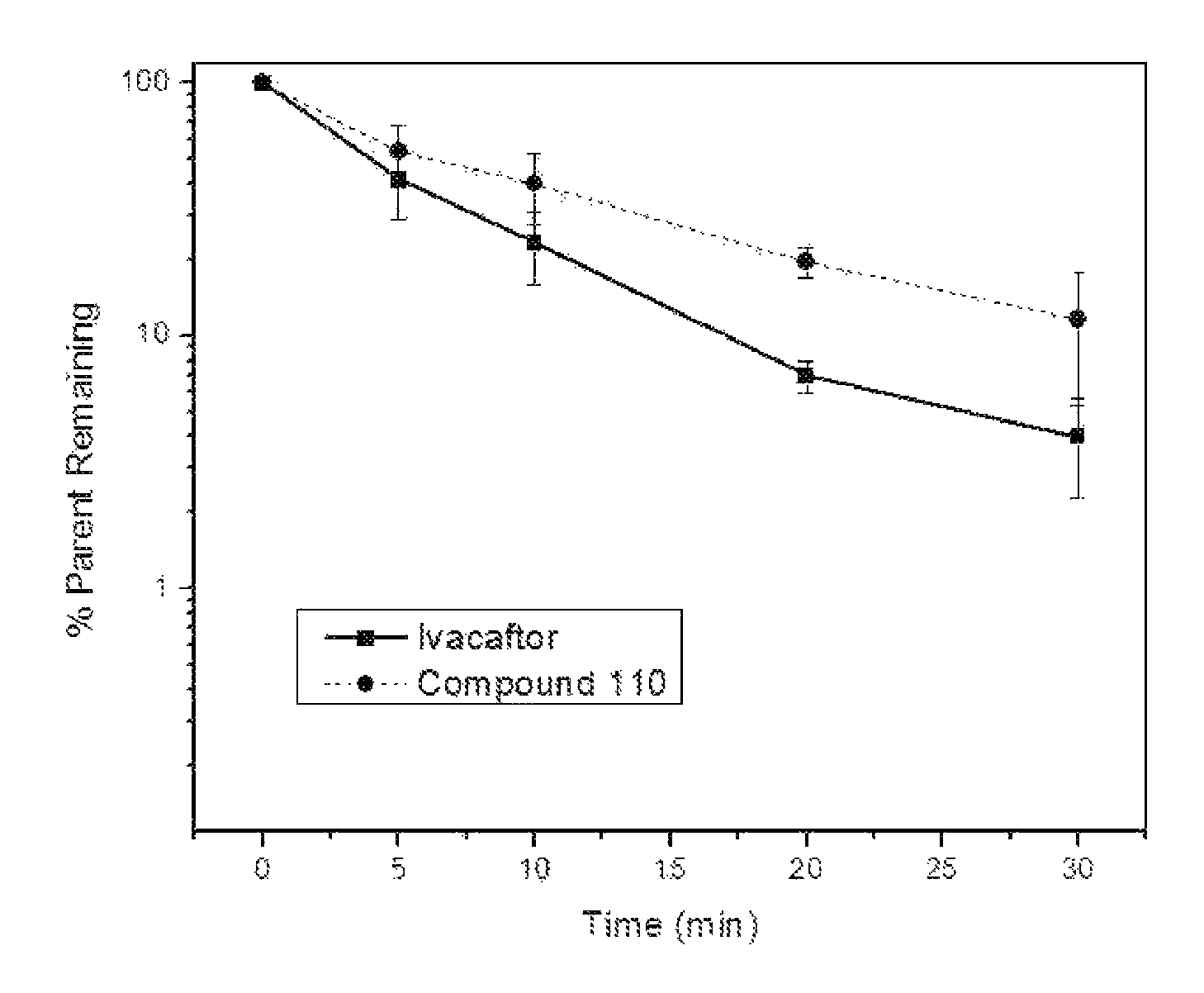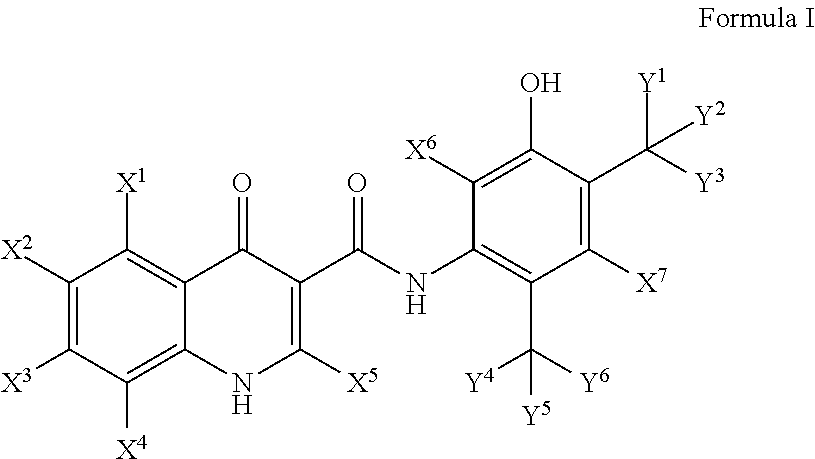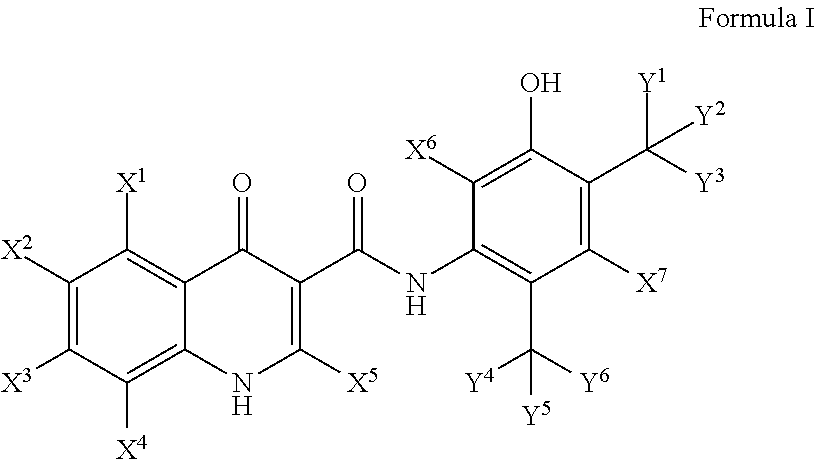Deuterated CFTR potentiators
a potentiator and deuterated cftr technology, applied in the field of deuterated cftr potentiators, can solve the problems of poor absorption, distribution, metabolism and/or excretion (adme) properties, poor adme properties, and many current medicines
- Summary
- Abstract
- Description
- Claims
- Application Information
AI Technical Summary
Benefits of technology
Problems solved by technology
Method used
Image
Examples
example 1
Synthesis of N-(2,4-Di-(tert-butyl-d9)-3,6-d2-5-hydroxyphenyl)-4-oxo-1,4-dihydroquinoline-3-carboxamide (Compound 110)
[0151]Compound 110 was prepared as outlined in Scheme 5 below.
[0152]
Step 1. 2,4-Di-(tert-butyl-d9)-3,5,6-d3-phenol (4a)
[0153]Intermediate 4a was prepared according to the procedure described for the synthesis for 2,4-di-tert-butyl-3,5-d2-phenol employing tert-butyl chloride-d9 in place of tert-butylchloride (Kurahashi, T.; Hada, M.; Fujii, H. J. Am. Chem. Soc. 2009, 131, 12394-12405): To a solution of phenol-d6 (459 mg, 4.59 mmol, 99 atom % D, Sigma Aldrich) and tert-butyl chloride-d9 (2.50 mL, 23.0 mmol, 98 atom % D, Cambridge Isotope Laboratories, Inc.) in 1,2-dichloroethane (10.0 mL) was added ReBr(CO)5 (19.0 mg, 0.0459 mmol). The reaction mixture was stirred at 85° C. for 15 hours at which time additional tert-butyl chloride-d9 (2.50 mL, 23.0 mmol, 98 atom % D, Cambridge Isotope Laboratories, Inc.) and ReBr(CO)5 (19.0 mg, 0.0459 mmol) was added. Stirring was cont...
example 2
Synthesis of N-(2-(tert-Butyl)-4-(tert-butyl-d9)-6-d-5-hydroxyphenyl)-4-oxo-1,4-dihydroquinoline-3-carboxamide (Compound 125)
[0158]Compound 125 was prepared as outlined in Scheme 6 below.
[0159]
Step 1. 2-(tert-Butyl-d9)-4-(tert-butyl)-6-d-phenol (7)
[0160]To a solution of 4-tert-butyl phenol (3.43 g, 22.7 mmol) and tert-butyl alcohol-d10 (3.00 mL, 31.8 mmol, 98 atom % D, Cambridge Isotope Laboratories, Inc.) in dichloromethane (40.0 mL) was added D2SO4 (1.50 mL, 99.5 atom % D, Sigma-Aldrich). The reaction was stirred at room temperature for 15 hours then was diluted with water and extracted with dichloromethane (3×100 mL). The organic layers were combined, washed with saturated NaHCO3, dried (Na2SO4), filtered and concentrated in vacuo. The resulting oil was purified by column chromatography (SiO2, 0-15% ethyl acetate / heptanes) to afford 7 (4.04 g, 83% yield) as a clear oil. 1H NMR (d6-DMSO, 400 MHz) δ 9.04 (s, 1H), 7.12 (d, J=2.4 Hz, 1H), 6.98 (dd, J=3.8, 2.5 Hz, 1H), 6.67 (d, J=8.3 ...
example 3
Synthesis of N-(2-(tert-Butyl)-4-(tert-butyl-d9)-5-hydroxyphenyl)-4-oxo-1,4-dihydroquinoline-3-carboxamide (Compound 106)
[0165]Compound 106 was prepared as outlined in Scheme 7 below.
[0166]
Step 1. 5-Amino-2-(tert-butyl-d9)-4-(tert-butyl)-phenol (12)
[0167]Compound 10 (298 mg, 1.29 mmol), prepared as disclosed in Example 2, was dissolved in 5M HCl in 2-propanol (20 mL) and the reaction was stirred at room temperature for 15 hours. The reaction was then concentrated in vacuo and taken back up in 5M HCl in 2-propanol (20 mL). After stirring for an additional 15 hours at room temperature, the reaction was concentrated in vacuo and diluted with saturated aqueous sodium bicarbonate (100 mL). The resulting aqueous solution was extracted with dichloromethane (3×50 mL). The organic layers were combined, dried (Na2SO4), filtered and concentrated in vacuo to afford 12 (240 mg, 81%) as a pink solid. 1H NMR (d6-DMSO, 400 MHz) δ 8.62 (s, 1H), 6.83 (s, 1H), 6.08 (s, 1H), 1.27 (s, 9H).
Step 2. N-(2-(...
PUM
| Property | Measurement | Unit |
|---|---|---|
| temperature | aaaaa | aaaaa |
| temperature | aaaaa | aaaaa |
| temperature | aaaaa | aaaaa |
Abstract
Description
Claims
Application Information
 Login to View More
Login to View More - R&D
- Intellectual Property
- Life Sciences
- Materials
- Tech Scout
- Unparalleled Data Quality
- Higher Quality Content
- 60% Fewer Hallucinations
Browse by: Latest US Patents, China's latest patents, Technical Efficacy Thesaurus, Application Domain, Technology Topic, Popular Technical Reports.
© 2025 PatSnap. All rights reserved.Legal|Privacy policy|Modern Slavery Act Transparency Statement|Sitemap|About US| Contact US: help@patsnap.com



